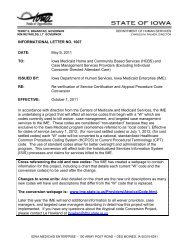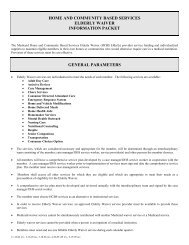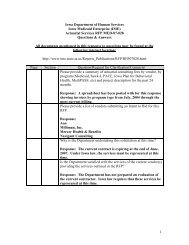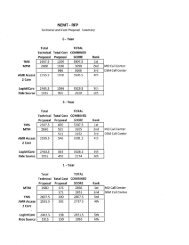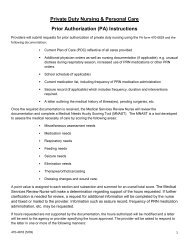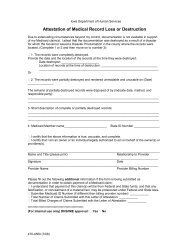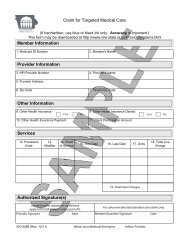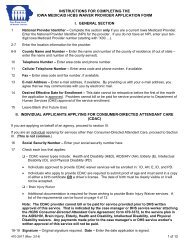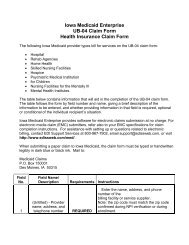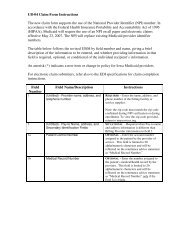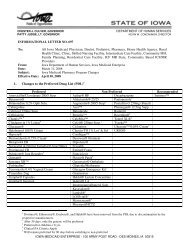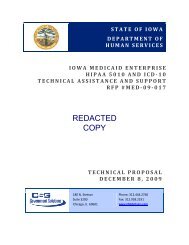Comm. 30 Medicaid for the Medically Needy - Iowa Department of ...
Comm. 30 Medicaid for the Medically Needy - Iowa Department of ...
Comm. 30 Medicaid for the Medically Needy - Iowa Department of ...
Create successful ePaper yourself
Turn your PDF publications into a flip-book with our unique Google optimized e-Paper software.
<strong>Iowa</strong> <strong>Department</strong> <strong>of</strong> Human Services<strong>Medicaid</strong><strong>for</strong> <strong>the</strong><strong>Medically</strong><strong>Needy</strong><strong>Comm</strong>. <strong>30</strong> (Rev. 7/09)<strong>Iowa</strong> <strong>Department</strong> <strong>of</strong> Human Services<strong>Medicaid</strong>para<strong>Medically</strong><strong>Needy</strong><strong>Comm</strong>. <strong>30</strong> (Rev. 7/09)
¿Qué es <strong>Medicaid</strong>?<strong>Medicaid</strong> es un programa que paga las facturas médicas de laspersonas elegibles. <strong>Medicaid</strong> también se conoce como Title 19.No confunda <strong>Medicaid</strong> con Medicare. Medicare es un seguro deFederal Social Security Administration.¿Qué es <strong>Medically</strong> <strong>Needy</strong>?<strong>Medically</strong> <strong>Needy</strong> es un programa de <strong>Medicaid</strong> que lo puede ayudara pagar sus facturas médicas si sus ingresos son bajos o el montode las facturas es igual o casi igual a sus ingresos.Puede obtener <strong>Medically</strong> <strong>Needy</strong>:• Si sus ingresos o sus recursos (activos) superan el límite pararecibir <strong>Medicaid</strong>, pero• No le alcanzan para pagar las facturas médicas.Es posible que <strong>Medically</strong> <strong>Needy</strong> no pague el total de sus facturasmédicas y usted deba pagar parte de las mismas.¿Quién puede recibir <strong>Medically</strong> <strong>Needy</strong>?Las mujeres embarazadas si:• El ingreso familiar supera el <strong>30</strong>0% del límite federal de pobreza(FPL) para un grupo familiar del mismo tamaño, incluido elbebé por nacer.• Los recursos familiares no superan $10,000.Los menores de 21años si los ingresos familiares superan ellímite establecido para recibir <strong>Medicaid</strong>.1What is <strong>Medicaid</strong>?<strong>Medicaid</strong> is a program that pays <strong>for</strong> medical bills <strong>for</strong> people whoare eligible. Ano<strong>the</strong>r name <strong>for</strong> <strong>Medicaid</strong> is Title 19.Don’t confuse <strong>Medicaid</strong> with Medicare. Medicare is an insuranceprogram through <strong>the</strong> Federal Social Security Administration.What is <strong>Medically</strong> <strong>Needy</strong>?<strong>Medically</strong> <strong>Needy</strong> is a <strong>Medicaid</strong> program that may help you withmedical bills if you have low income or high medical bills that useup most or all <strong>of</strong> your income.You may be able to get <strong>Medically</strong> <strong>Needy</strong>:• If you have too much income or too many resources (assets) toget regular <strong>Medicaid</strong>, but• Not enough to pay your medical bills.<strong>Medically</strong> <strong>Needy</strong> may not pay all <strong>of</strong> your medical bills. You maystill have to pay some <strong>of</strong> your medical bills.Who can get <strong>Medically</strong> <strong>Needy</strong>?Pregnant women if:• Family income is over <strong>30</strong>0% <strong>of</strong> <strong>the</strong> federal poverty limits (FPL)<strong>for</strong> a household <strong>of</strong> <strong>the</strong> same size. This includes <strong>the</strong> unbornbaby.• Family resources are not more than $10,000.People under age 21 if family income is over <strong>the</strong> income limit <strong>for</strong>regular <strong>Medicaid</strong>.1
People who are aged, blind or disabled who:• Would be eligible <strong>for</strong> SSI (Supplemental Security Income)except that income or resources (assets) are over <strong>the</strong> limit, and• Are age 65 or older, or• Are legally blind as defined by Social Security, or• Are disabled as defined by Social Security.If you are disabled and working, ask your <strong>Department</strong> <strong>of</strong> HumanServices (DHS) worker about <strong>the</strong> <strong>Medicaid</strong> <strong>for</strong> Employed Peoplewith Disabilities (MEPD) program.Adults who care <strong>for</strong> dependent children under age 18 or age19 and still in school, if:• They are <strong>the</strong> parent, aunt, uncle, grandparent or disabledstepparent <strong>of</strong> a dependent child, and• Their income is over <strong>the</strong> income limit <strong>for</strong> <strong>Medicaid</strong> <strong>for</strong> families,or• Their resources (assets) are over <strong>the</strong> resource limit <strong>for</strong><strong>Medicaid</strong> <strong>for</strong> families.Terms You Should KnowThere are some terms used in this booklet that you may not befamiliar with:When we use: We mean:Certification period The time period that a person may bedetermined eligible <strong>for</strong> <strong>Medically</strong> <strong>Needy</strong>.Conditionally eligiblepersonFamily-related<strong>Medicaid</strong><strong>Medicaid</strong> coveredservicesA person who is approved <strong>for</strong> <strong>Medically</strong><strong>Needy</strong> with a spenddown but has not metspenddown.<strong>Medicaid</strong> <strong>for</strong> pregnant women, children orpersons caring <strong>for</strong> children.Medical services payable by <strong>Medicaid</strong>.MNIL The MNIL is <strong>the</strong> <strong>Medically</strong> <strong>Needy</strong> IncomeLevel. The MNIL is used to determine <strong>the</strong>spenddown amount.2Las personas ancianas, ciegas o discapacitadas que:• califiquen para recibir Seguridad de Ingreso Suplementario(SSI) excepto en el caso que los ingresos o recursos (activos)superen el límite, y que• tengan 65 años o más, o• estén legalmente ciegas, como lo define Social Security, o• estén discapacitadas, como lo define Social Security.Si está discapacitado y trabaja, pregúntele a un asistente de DHS(<strong>Department</strong> <strong>of</strong> Human Services) sobre el programa <strong>Medicaid</strong> paraEmpleados Discapacitados (MEPD).y • son los padres, tíos, abuelos o padrastros de un menor a sucargo, y• sus ingresos superan el límite de <strong>Medicaid</strong> para familias, o• sus recursos (activos) superan el límite establecido por<strong>Medicaid</strong> para familias.que aún asisten a la escuela, si:Los adultos con menores de 18 años o de 19 años a su cargoTérminos que debe conocerExisten algunos términos que se utilizan en este folleto y con loscuales debe familiarizarse:Cuando usamos: Queremos decir:Período de certificación El período de tiempo por el cual una personaes considerada elegible para <strong>Medically</strong><strong>Needy</strong>.Persona elegible condicionalmentePersona aprobada para <strong>Medically</strong> <strong>Needy</strong>con deducible que no ha sido cubierto.<strong>Medicaid</strong> familiar <strong>Medicaid</strong> para mujeres embarazadas, niñosy personas con menores a cargo.Servicios cubiertos por<strong>Medicaid</strong>Prestaciones médicas pagadas por <strong>Medicaid</strong>.MNIL El MNIL es el Nivel de Ingresos de <strong>Medically</strong><strong>Needy</strong>. Se utiliza para determinar el montode su deducible o “spenddown”.2
Cuando usamos: Queremos decir:Ingreso neto contabilizableBeneficiario Calificadode Medicare (QMB)3El ingreso bruto menos los descuentos permitidospor DHS.Un programa de <strong>Medicaid</strong> que paga las primasde Medicare (Partes A y B), los deduciblesy los copagos de personas con ingresosiguales o inferiores al 100% del nivel federalde pobreza.Recursos Recursos (activos) son cosas como cuentasbancarias, propiedades, vehículos, etc.Pariente responsable Padres, cónyuge o padrastros que viven conla persona que recibe <strong>Medically</strong> <strong>Needy</strong>. Susingresos se utilizan para determinar el montodel deducible. Sus facturas médicas puedenser usadas para cubrir el deducible.Período retroactivo Los tres meses anteriores al mes de la solicitud.Beneficiario de Medicare Programas <strong>Medicaid</strong> que pagan solamentecon Bajos Ingresos Específicos(SLMB) y Be-personas cuyos ingresos son superiores alla prima de Medicare Parte B de aquellasneficiario de Medicare 100% del nivel federal de pobreza pero inferioresal 135% del nivel federal de pobreza.con Bajos Ingresos EspecíficosAmpliados (E-SLMB)Deducible(“Spenddown”)El “spenddown” es como un deducible. Elmonto del deducible es la diferencia entresus ingresos netos contabilizables y el MNIL.Es el proceso de descontar los gastos médicosde sus ingresos hasta alcanzar el montodel MNIL. Se considera que cumplió con eldeducible cuando el monto de sus ingresosy del MNLI son iguales. En ese momento,<strong>Medicaid</strong> comenzará a pagar gastos médicos.SSI-Related <strong>Medicaid</strong> <strong>Medicaid</strong> para personas ancianas, discapacitadaso ciegas.When we use: We mean:Net countable income Gross income minus deductions that DHSallows.Qualified MedicareBeneficiary (QMB)A <strong>Medicaid</strong> program that pays <strong>the</strong>Medicare premiums (Part A and B),deductibles, and copayments <strong>for</strong> peoplewith income at or below 100% <strong>of</strong> <strong>the</strong>federal poverty level.Resources Resources (assets) are things like bankaccounts, property, cars, etc.Responsible relative A parent, spouse, or stepparent living in<strong>the</strong> household <strong>of</strong> <strong>the</strong> person on <strong>Medically</strong><strong>Needy</strong>. Their income is used to determine<strong>the</strong> spenddown amount. Their medicalbills may be used to meet <strong>the</strong> spenddown.Retroactive period The three months be<strong>for</strong>e <strong>the</strong> month <strong>of</strong>application.Specified Low IncomeMedicare Beneficiary(SLMB) andExpanded—SpecifiedLow Income MedicareBeneficiary (E-SLMB)<strong>Medicaid</strong> programs that only pay <strong>the</strong>Medicare Part B premium <strong>for</strong> people withincome above 100% <strong>of</strong> <strong>the</strong> federal povertylevel, but below 135% <strong>of</strong> <strong>the</strong> federalpoverty level.Spenddown Spenddown is like a deductible. Thespenddown amount is <strong>the</strong> differencebetween your net countable income and<strong>the</strong> MNIL. Spenddown is <strong>the</strong> process <strong>of</strong>using medical expenses to lower yourincome to <strong>the</strong> MNIL. Medical expensesare deducted from <strong>the</strong> spenddown amount.When income is reduced to <strong>the</strong> MNIL withmedical expenses, spenddown is met.When spenddown is met, <strong>Medicaid</strong>eligibility will begin.SSI-Related <strong>Medicaid</strong> <strong>Medicaid</strong> <strong>for</strong> persons who are aged,disabled or blind.3
What are <strong>the</strong> rules <strong>for</strong> <strong>Medically</strong> <strong>Needy</strong>?You may get <strong>Medically</strong> <strong>Needy</strong> if:• Your resources are below certain limits and• Your income is equal to or less than <strong>the</strong> <strong>Medically</strong> <strong>Needy</strong>Income Level (MNIL) or• You can spend your income down to <strong>the</strong> MNIL.If you are pregnantor an adult whocares <strong>for</strong> a childIf you are aged,blind or disabledindividual orcoupleIf you are a childunder age 21Resource Limit $10,000 $10,000 No limitWhat counts as aresource?Only “liquid”resourcesSome examples:• Cash• Checkingaccounts• Saving accounts• Money marketfunds• Mutual funds• Stocks andbonds• Certificate <strong>of</strong>deposits• Anything thatcan be easilychanged to cash“Liquid” and nonliquidresourcesSome examples:• Cash• Checkingaccounts• Saving accounts• Money marketfunds• Mutual funds• Stocks andbonds• Certificate <strong>of</strong>deposits• Real estate youare not living in• Contracts <strong>for</strong> <strong>the</strong>sale <strong>of</strong> realproperty• The value <strong>of</strong>your car• The cash value<strong>of</strong> your lifeinsurancepolicies• Annuities• IRAs• Keogh plansMay be countedas a resource<strong>Medicaid</strong>qualifying trusts<strong>Medicaid</strong>qualifying trusts4¿Cuáles son las normas de <strong>Medically</strong> <strong>Needy</strong>?Puede obtener <strong>Medically</strong> <strong>Needy</strong> si:• sus recursos son inferiores a un límite determinado y• sus ingresos son iguales o inferiores al Nivel de Ingresos de<strong>Medically</strong> <strong>Needy</strong> (MNIL), o• puede pagar deducibles hasta equiparar el MNIL.Embarazadas oadultos con menoresa cargoParejas o individuosancianos,ciegos o discapacitadosMenoresde 21 añosLímite de recursos $10,000 $10,000 Sin límite¿Qué se consideracomo recurso?Solo recursos Recursos líquidos y“líquidos”no líquidosEjemplos:Ejemplos:• Efectivo • Efectivo• Cuentas de cheques• Cuentas de cheques• Cuentas de ahorro• Cuentas de ahorro• Fondos del mercadode valores• Fondos del mercadode valores• Fondos de inversión• Fondos de inversión• Acciones y bonos• Certificados de• Acciones y bonosdepósito• Inmuebles (que no• Certificados de sean su vivienda)depósito • Contratos de ventade inmuebles• Todo lo quepueda ser convertidoen dinero hículo• El valor de su ve-en efectivo fácilmentvode sus pólizas• El valor en efecti-de seguros de vida• Anualidades• Planes de retiro• Planes KeoghPueden ser contabilizadoscomorecursosFideicomisosaprobados por<strong>Medicaid</strong>Fideicomisosaprobados por<strong>Medicaid</strong>4
¿Qué ingresos se contabilizan? Se contabilizan los ingresoslaborales y no laborales de todas las personas que podrían serelegibles para <strong>Medically</strong> <strong>Needy</strong> y de los parientes responsables.¿Cómo funciona el MNIL? El MNIL es el Nivel de Ingresos de<strong>Medically</strong> <strong>Needy</strong>. Si el total de su ingreso neto contabilizable esigual o inferior al MNIL, todos los miembros elegibles de su familiarecibirán <strong>Medicaid</strong> sin deducible. Nota: El ingreso neto es elingreso bruto menos los descuentos autorizados por DHS .Si el total de su ingreso neto contabilizable es superior al MNIL,tendrá que cumplir con el deducible antes de recibir <strong>Medicaid</strong>. Sipaga primas de seguro médico o tiene facturas médicas, lasmismas serán utilizadas para ayudarle a cubrir el deducible.Cantidad de Personasen el Grupo FamiliarEl MNIL mensual es1 $4832 $4833 $5664 $6665 $7336 $8167 $8918 $9759 $1,05810 $1,158¿Por cuánto tiempo recibiré <strong>Medicaid</strong> si no tengo deducible?Recibirá <strong>Medicaid</strong> si el deducible es igual a cero. Su caso de<strong>Medically</strong> <strong>Needy</strong> será revisado una vez por año y cuando in<strong>for</strong>mesobre algún cambio. Si in<strong>for</strong>ma un cambio que afecta suelegibilidad, podría tener que cumplir con el deducible. Porejemplo, sus ingresos aumentan. <strong>Medicaid</strong> finalizará si ya no eselegible. Por ejemplo, se muda a otro estado.5What income is counted? Earned and unearned income <strong>of</strong> allpersons who might be eligible <strong>for</strong> <strong>Medically</strong> <strong>Needy</strong> and personswho are considered responsible relatives are counted.How does <strong>the</strong> MNIL work? The MNIL is <strong>the</strong> <strong>Medically</strong> <strong>Needy</strong>Income Level. If your total net countable income is equal to or lessthan <strong>the</strong> MNIL, all eligible members <strong>of</strong> your family will get <strong>Medicaid</strong>without a spenddown. Note: Net countable income is your grossincome after deductions that DHS allows.If your total net countable income is more than <strong>the</strong> MNIL, you willneed to meet a spenddown be<strong>for</strong>e you get <strong>Medicaid</strong>. If you payhealth insurance premiums or have medical bills, <strong>the</strong>se may beused to help meet your spenddown.Number <strong>of</strong> Personsin <strong>the</strong> HouseholdThe monthly MNIL is1 $4832 $4833 $5664 $6665 $7336 $8167 $8918 $9759 $1,05810 $1,158How long will I get <strong>Medicaid</strong> if I do not have a spenddown? Ifyou have a zero spenddown, you will get <strong>Medicaid</strong>. Your <strong>Medically</strong><strong>Needy</strong> case will be reviewed when you report a change and once ayear. If you report a change that affects your eligibility, you couldhave a spenddown. For example, your income goes up. <strong>Medicaid</strong>will end if you are no longer eligible. For example, you move toano<strong>the</strong>r state.5
How long will I get <strong>Medicaid</strong> if I do have a spenddown? If youhave to meet a spenddown, you will have a two-month certificationperiod. Once you meet spenddown, you will get <strong>Medicaid</strong> <strong>for</strong> thosetwo months. After <strong>the</strong> certification period ends, you will need toapply again.How is <strong>the</strong> spenddown met?Medical bills are used to meet <strong>the</strong> spenddown. You should look atyour Notice <strong>of</strong> Decision to find out whose medical bills can be usedto meet spenddown. The Notice <strong>of</strong> Decision tells you who isconditionally eligible (family members who can get <strong>Medicaid</strong> once<strong>the</strong> spenddown is met) and who are responsible relatives. Themedical bills <strong>of</strong> both people who are conditionally eligible and <strong>the</strong>responsible relatives may be used to meet spenddown.These medical bills are deducted from <strong>the</strong> spenddown when yourcase is approved:• Medicare premiums• Health insurance premiumsYou need to tell your medical provider that you are on <strong>Medically</strong><strong>Needy</strong>. Show <strong>the</strong> Notice <strong>of</strong> Decision to <strong>the</strong> provider. Ask <strong>the</strong>m tosend medical claims you owe, or have already paid during <strong>the</strong>certification period, to <strong>the</strong> <strong>Iowa</strong> <strong>Medicaid</strong> Enterprise. If you got <strong>the</strong>medical service be<strong>for</strong>e your certification period, ask <strong>the</strong> provider tosend <strong>the</strong> claim to your DHS worker. These bills may be used tomeet your spenddown:• Bills <strong>for</strong> medical services during <strong>the</strong> current certification period.These bills may be paid or unpaid.• Old medical bills that you still owe and that have not alreadybeen used to meet a spenddown. (Talk to your DHS worker tosee if any <strong>of</strong> <strong>the</strong>se bills can be used to meet your spenddown).• Bills <strong>for</strong> medical services during <strong>the</strong> retroactive period that havenot already been used <strong>for</strong> spenddown, can be used in <strong>the</strong>certification period immediately following <strong>the</strong> retroactive period.Bills from <strong>the</strong> retroactive period may be paid or unpaid.6¿Por cuánto tiempo recibiré <strong>Medicaid</strong> si tengo deducible? Sitiene que cumplir con el deducible, tendrá un período decertificación de dos meses. Una vez que cubra el deducible,recibirá <strong>Medicaid</strong> por esos dos meses. Cuando el período decertificación termine, deberá solicitar <strong>Medicaid</strong> nuevamente.¿Cómo se cubre el deducible?Se usan las facturas médicas para cubrir el deducible. Lea laNotificación de Resolución; en la misma se le in<strong>for</strong>ma qué facturasmédicas puede usar para cumplir con el deducible. En la Notificaciónde Resolución también se le in<strong>for</strong>ma quiénes son elegiblescondicionalmente (miembros de su familia que pueden obtener<strong>Medicaid</strong> una vez que cubra el deducible) y quiénes sonconsiderados familiares responsables. Puede usar las facturasmédicas de las personas elegibles condicionalmente y de losfamiliares responsables para cubrir el deducible.Cuando su caso sea aprobado, las siguientes facturas médicas serándescontadas del deducible:• Primas de Medicare• Primas del seguro médicoDebe decirle a su proveedor de servicios médicos que tiene <strong>Medically</strong><strong>Needy</strong>. Muéstrele la Notificación de Resolución al proveedor. Pídaleque envíe a <strong>Iowa</strong> <strong>Medicaid</strong> Enterprise las facturas que usted adeudeo que haya abonado durante el período de certificación. Si recibióatención médica con anterioridad al período de certificación, pídale alproveedor que envíe la solicitud de pago a su asistente DHS. Lassiguientes facturas pueden ser usadas para cubrir el deducible:• Facturas de prestaciones médicas durante el actual período decertificación. Estas facturas pueden haber sido pagadas o no.• Facturas viejas de gastos médicos que aún adeuda y que no hansido utilizadas para cubrir el deducible. (Hable con su asistente deDHS para ver si alguna de dichas facturas se puede utilizar paracumplir con el deducible).• Las facturas correspondientes a prestaciones médicas recibidasdurante el período retroactivo que no hayan sido utilizadas paracubrir el deducible, pueden ser usadas durante el período decertificación inmediatamente posterior al período retroactivo.Estas facturas pueden haber sido pagodas o no.6
• Las facturas médicas que no se utilicen para cubrir el deducibledurante un período de certificación, pueden usarse durante unperíodo de certificación posterior si:• se cubrió el deducible de dicho período de certificación, y• la factura médica no se había usado previamente paracumplir con el deducible, y• <strong>Medicaid</strong> no pagará dicha factura (por ejemplo, facturas defamiliares responsables o de una clínica), y• usted aún adeuda dicha factura.Las facturas médicas se consideran una sola vez. Si no hay suficientesfacturas para cubrir el deducible del período de certificación actual, no selas puede volver a usar para un período posterior. Algunas facturas no sepueden usar para cubrir el deducible. Se le notificará si una facturamédica no puede ser usada.Ejemplo sobre cómo se calcula y cubre el deducible:Ejemplo 1Miembros del grupo familiar: Familia Smith—4 miembrosPeríodo de Certificación : Noviembre y diciembreIngreso neto mensual contabilizable(Ingresos después de los descuentos): $600 + $500 = $1,100MNIL para una familia de 4-miembros: $666 + $666 = -$1,332Monto del deducible: $ 0La familia no tendrá que cumplir con el deducible porque sus ingresos soninferiores al MNIL durante los dos meses. La familia recibirá <strong>Medicaid</strong> porque notiene deducible. La familia deberá in<strong>for</strong>mar cambios.Ejemplo 2Miembros del grupo familiar: Sr. y Sra. Jones (mayores de 65 años)Período de Certificación: Noviembre y diciembreIngreso neto contabilizable(Ingresos después de los descuentos) $1,200 + $1,200 = $2,400MNIL para una pareja: $ 483 + $ 483 = -$ 966Monto del deducible: $1,434Antes de recibir <strong>Medicaid</strong>, el Sr. y la Sra. Jones deberán reunir facturas médicaspor $1,434 para cubrir el deducible.En el mes de noviembre la Sra. Jones tuvo las siguientes facturas médicas:Gastos de sanatorio por dos semanas $1,720.60Copago abonado al médico $ 20.007Ejemplo 2—Continúa en la página siguiente• Medical bills not needed to meet a spenddown in a certificationperiod, may be used <strong>for</strong> a later certification period if:• The spenddown was met in <strong>the</strong> certification period, and• The medical bill was not previously used to meetspenddown, and• <strong>Medicaid</strong> will not pay <strong>for</strong> <strong>the</strong> medical bill (such asresponsible relative bills or nursing facility bill), and• You still must pay <strong>the</strong> medical bill.Medical bills can be considered only once. If <strong>the</strong>re are not enoughmedical bills to meet <strong>the</strong> spenddown <strong>for</strong> <strong>the</strong> current certificationperiod, <strong>the</strong>y cannot be used <strong>for</strong> a later certification period. Sometypes <strong>of</strong> medical bills cannot be used to meet spenddown. You willget a notice if <strong>the</strong> medical bill cannot be used.Examples <strong>of</strong> how spenddown is determined and met:Example 1Family members: 4-member Smith familyCertification period: November and DecemberNet countable monthly income(Income after deductions): $600 + $500 = $1,100MNIL <strong>for</strong> 4-member family: $666 + $666 = -$1,332Spenddown amount: $ 0The family will not have to meet a spenddown because <strong>the</strong>ir income is less than<strong>the</strong> MNIL during <strong>the</strong> two months. Since <strong>the</strong> family does not have a spenddown,<strong>the</strong> family will get <strong>Medicaid</strong>. The family will need to report changes.Example 2Family members: Mr. and Mrs. Jones (both over age 65)Certification period: November and DecemberNet countable income(Income after deductions) $1,200 + $1,200 = $2,400MNIL <strong>for</strong> a couple: $ 483 + $ 483 = -$ 966Spenddown amount: $1,434Be<strong>for</strong>e Mr. and Mrs. Jones can get <strong>Medicaid</strong> <strong>the</strong>y will need to have $1,434 inmedical bills to apply to <strong>the</strong>ir spenddown.Mrs. Jones has <strong>the</strong> following medical bills in November:A nursing facility charge <strong>for</strong> two weeks $1,720.60Co-payment at <strong>the</strong> doctor $ 20.007Example 2—Continued Next Page
Spenddown is met using <strong>the</strong> nursing facility costs.Now that spenddown is met, <strong>Medicaid</strong> will pay <strong>the</strong> $20.00 co-payment to <strong>the</strong>doctor and will pay any additional qualifying medical bills that Mr. and Mrs. Joneshave in November and December.Mr. and Mrs. Jones also have Medicare coverage including Medicare drugcoverage. <strong>Medicaid</strong> pays <strong>for</strong> <strong>the</strong>ir Medicare Part B premiums because <strong>the</strong>y met<strong>the</strong> spenddown. Medicare helps pay <strong>for</strong> <strong>the</strong>ir Medicare Part D drug plan <strong>for</strong>remaining months in <strong>the</strong> year.Note: <strong>Medicaid</strong> will not pay <strong>for</strong> any drug costs <strong>for</strong> persons who have Medicarecoverage. The Medicare Part B premium is not used to meet spenddownbecause <strong>Medicaid</strong> pays it <strong>for</strong> <strong>the</strong> months that <strong>the</strong> spenddown is met.<strong>Medicaid</strong> will not pay nursing facility costs <strong>for</strong> persons eligible <strong>for</strong> <strong>Medically</strong><strong>Needy</strong>. Mr. and Mrs. Jones will need to pay <strong>the</strong> nursing facility costs.• Dígale a su médico que ha solicitado <strong>Medically</strong> <strong>Needy</strong>.• Pregúntele si trabaja con <strong>Medicaid</strong>.• Dígale que usted deberá pagar las facturas médicas que se utilicenpara cubrir el deducible.• Muéstrele la Notificación de Resolución de <strong>Medically</strong> <strong>Needy</strong> y sunúmero de identificación estatal, o• Pídale a su asistente de DHS un <strong>for</strong>mulario en el que se indique queha solicitado <strong>Medically</strong> <strong>Needy</strong> y que, si es aprobado, podría tener quecumplir con un deducible. Muéstrele el <strong>for</strong>mulario al médico.• Pídale al médico que presente la solicitud de pago por prestaciones a<strong>Medicaid</strong>. La misma será descontada del deducible.• Es posible que el médico le pida que abone en el momento querecibe las prestaciones. Si no puede pagar el total de la factura,pregúntele si puede pagar en cuotas.I have not met my spenddown and need to see adoctor. What do I tell my doctor?• Tell your doctor that you have applied <strong>for</strong> <strong>Medically</strong> <strong>Needy</strong>.• Ask if <strong>the</strong> doctor takes <strong>Medicaid</strong>.• Tell your doctor that you will have to pay <strong>the</strong> medical bills used tomeet <strong>the</strong> spenddown.• Show your doctor your <strong>Medically</strong> <strong>Needy</strong> Notice <strong>of</strong> Decision and yourstate ID number, or• Ask your DHS worker <strong>for</strong> a <strong>for</strong>m that states you applied <strong>for</strong> <strong>Medically</strong><strong>Needy</strong> and that you may have a spenddown to meet if approved.Show this <strong>for</strong>m to your doctor.• Ask <strong>the</strong> doctor to submit <strong>the</strong> claim to <strong>Medicaid</strong>. The claim will <strong>the</strong>n beapplied to meet spenddown.• The doctor may ask you to pay your spenddown amount at <strong>the</strong> time<strong>of</strong> service. If you cannot pay all <strong>of</strong> <strong>the</strong> bill, ask if you can makepayments.Who do I call when I have problems with myspenddown?• Call your DHS worker if you have problems or questions about yourspenddown.• Call 1-800-338-8366, <strong>the</strong> toll-free number on <strong>the</strong> back <strong>of</strong> your MedicalAssistance Eligibility Card, when you are billed <strong>for</strong> <strong>Medicaid</strong> services(that were not used to meet spenddown) or payment <strong>for</strong> <strong>the</strong> bill isdenied.8El deducible se cubre utilizando las facturas del sanatorio.Una vez que se cubrió el deducible, <strong>Medicaid</strong> pagará los $20.00 de copago almédico y todas las demás facturas médicas preestablecidas que el Sr. y la Sra.Jones reciban durante noviembre y diciembre.El Sr. y la Sra. Jones también tienen cobertura Medicare, incluida coberturaMedicare para medicamentos. <strong>Medicaid</strong> pagará sus primas de Medicare Parte Bporque cumplieron con el deducible. Medicare los ayudará a pagar el plan paramedicamentos de Medicare Parte D durante los meses restantes del año.Nota: <strong>Medicaid</strong> no pagará el costo de los medicamentos si tiene Medicare. Laprima de Medicare Parte B no puede ser usada para cubrir el deducible porque<strong>Medicaid</strong> paga la prima durante los meses en que se cumpla con el deducible.<strong>Medicaid</strong> no les pagará el costo de sanatorio a las personas que sean elegiblespara <strong>Medically</strong> <strong>Needy</strong>. El Sr. y la Sra. Jones deberán pagarlo.No he cubierto el deducible y necesito ir al médico.¿Qué le digo a mi doctor?¿A quién debo llamar si tengo problemas con eldeducible?• Llame a su asistente de DHS si tiene problemas o desea hacerpreguntas con respecto al deducible.• Llame al 1-800-338-8366, al número de llamadas gratuitas que figuraen el dorso de su tarjeta Assistance Eligibility Card, cuando lefacturen servicios de <strong>Medicaid</strong> (que no hayan sido usados para cubrirel deducible) o cuando el pago de una factura sea denegado.8
¿Cómo y dónde hago la solicitud?• Puede pedir el <strong>for</strong>mulario de solicitud en la <strong>of</strong>icina local de DHS(<strong>Department</strong> <strong>of</strong> Human Services), o• Llamar y pedir que se lo manden por correo, o• Imprimir el <strong>for</strong>mulario electrónico de la página de Internethttp://www.dhs.state.ia.us/policyanalysis/PolicyManualPages/Manual_Documents/Forms/470-2927.pdfResponda todas las preguntas del <strong>for</strong>mulario y llévelo o envíelopor correo o por fax a la <strong>of</strong>icina de DHS.¿Puedo recibir <strong>Medicaid</strong> para los meses anteriores ami solicitud?Si tiene facturas médicas de los tres meses anteriores a susolicitud, también puede obtener <strong>Medicaid</strong> para dichos meses.Esto se llama período retroactivo. Dígale a su asistente de DHSque recibió prestaciones médicas durante esos meses para quepueda determinar su elegibilidad durante el período retroactivo.¿Cuánto tiempo debo esperar para saber si recibiré<strong>Medically</strong> <strong>Needy</strong>?DHS tiene un plazo de 45 días para decidir si es elegible para<strong>Medically</strong> <strong>Needy</strong>. Si in<strong>for</strong>mó que está discapacitado, DHS debeesperar hasta que Social Security Administration o DisabilityDetermination Services nos confirmen que usted está discapacitado.Esto puede tomar 90 días o más. Si DHS no le envía una notificaciónen un período de 45 días (o 90 días en los casos de incapacidad),tendrá derecho a presentar una apelación.9How and where do I apply?• You may get an application at your local <strong>Department</strong> <strong>of</strong> HumanServices (DHS) <strong>of</strong>fice, or• You can call and ask to have one mailed to you, or• You can print an application from <strong>the</strong> Internet athttp://www.dhs.state.ia.us/policyanalysis/PolicyManualPages/Manual_Documents/Forms/470-2927.pdfAnswer <strong>the</strong> questions on <strong>the</strong> application and take, mail or fax itback to <strong>the</strong> DHS <strong>of</strong>fice.Can I get <strong>Medicaid</strong> <strong>for</strong> any months be<strong>for</strong>e I applied?If you had medical bills during <strong>the</strong> three months be<strong>for</strong>e yourapplication, you may also be able to get <strong>Medicaid</strong> <strong>for</strong> those threemonths. This is called <strong>the</strong> retroactive period. Tell your DHSworker about <strong>the</strong> months you got medical services so <strong>the</strong>y can lookat your eligibility <strong>for</strong> <strong>the</strong> retroactive months.How long do I have to wait to hear if I get <strong>Medically</strong><strong>Needy</strong>?DHS has up to 45 days to decide if you can get <strong>Medically</strong> <strong>Needy</strong>. Ifyou said that you are disabled, DHS has to wait until <strong>the</strong> SocialSecurity Administration or Disability Determination Services tells usthat you are disabled. This may take up to 90 days or longer. If DHShas not sent you a notice within 45 days (or 90 days in <strong>the</strong> case <strong>of</strong> adisability), you have <strong>the</strong> right to file an appeal.9
Will I get a Medical Assistance Eligibility Card?Yes. Once spenddown is met, you will get a Medical AssistanceEligibility Card.Keep this card until you get a new card, even if you do not meet aspenddown <strong>for</strong> your next certification period. The MedicalAssistance Eligibility Card may be used <strong>for</strong> months in which youmeet spenddown.The Medical Assistance Eligibility Card may also be given to <strong>the</strong>provider during <strong>the</strong> time period you are meeting your spenddown.By showing <strong>the</strong> card to <strong>the</strong> provider, your medical bills will beapplied to your spenddown. You will need to pay <strong>the</strong> medical billsused <strong>for</strong> spenddown.If you lose your card, please contact Member Services at(800) 338-8366 (in <strong>the</strong> Des Moines Area call 725-1003) or call yourlocal DHS <strong>of</strong>fice.What does <strong>Medicaid</strong> cover?Ask us <strong>for</strong> a copy <strong>of</strong> <strong>Comm</strong>. 20, Your Guide to <strong>Medicaid</strong>. It will tellyou about services that are covered by <strong>Medicaid</strong>. However,<strong>Medicaid</strong> will not pay <strong>for</strong> <strong>the</strong> following services <strong>for</strong> people eligibleonly <strong>for</strong> <strong>Medically</strong> <strong>Needy</strong>:• Care in nursing facilities, intermediate care facilities <strong>for</strong> <strong>the</strong>mentally retarded or skilled nursing facilities.• Care in a facility licensed <strong>for</strong> psychiatric care.What doctor can I see?You will need to show your <strong>Medicaid</strong> Assistance Eligibility card toyour health care providers be<strong>for</strong>e you get medical care. Not allhealth care providers take <strong>Medicaid</strong>. If you do not have a <strong>Medicaid</strong>card yet, see page 8 - ”I have not met my spenddown and need tosee a doctor. What do I tell my doctor? ”10¿Recibiré la Tarjeta de Elegibilidad para AsistenciaMédica (Medical Assistance Eligibility Card)?Sí. Una vez que cumpla con el deducible, recibirá la Tarjeta deElegibilidad para Asistencia Médica.Conserve esta tarjeta hasta que reciba una nueva, aunque nohaya cubierto el deducible de su próximo período de certificación.Puede usar la Tarjeta de Elegibilidad para Asistencia Médicadurante los meses en que cumpla con el deducible.También le puede entregar la tarjeta de asistencia médica a suproveedor de atención médica durante el período en que cumplacon el deducible. Si le muestra la tarjeta al proveedor, las facturasmédicas se usarán para cubrir el deducible. Deberá pagar lasfacturas médicas que se utilicen para cubrir el deducible.Si pierde la tarjeta, comuníquese con el Servicio de Atención alCliente al (800) 338-8366 (en el área de Des Moines llame al 725-1003) o llame a la <strong>of</strong>icina local de DHS.¿Qué cubre <strong>Medicaid</strong>?Pida una copia de <strong>Comm</strong>. 20, Su Guía para <strong>Medicaid</strong>. Ahíencontrará in<strong>for</strong>mación sobre las prestaciones cubiertas por<strong>Medicaid</strong>. Sin embargo, <strong>Medicaid</strong> no pagará las siguientesprestaciones si es elegible para <strong>Medically</strong> <strong>Needy</strong> únicamente:• Atención médica en sanatorios, establecimientos de atenciónintermedia para pacientes con retraso mental oestablecimientos de atención médica especializada.• Atención médica en establecimientos autorizados para <strong>of</strong>recertratamiento psiquiátrico.¿A qué médicos puedo visitar?Antes de ser atendido por sus proveedores de atención médica,muéstreles su tarjeta de asistencia médica. No todos losproveedores aceptan <strong>Medicaid</strong>. Si aún no tiene su tarjeta de<strong>Medicaid</strong>, lea la sección ”No he cubierto el deducible y necesito iral médico. ¿Qué le digo a mi doctor?” en la página 8.10
¿Debo pagar las prestaciones médicas que<strong>Medicaid</strong> no cubre?Sí. Después de cumplir con el deducible, recibirá una Notificaciónsobre el Estado del Deducible (“Notice <strong>of</strong> Spenddown Status”)in<strong>for</strong>mándole qué facturas fueron utilizadas para cumplir con eldeducible y si el mismo fue cubierto. Es su responsabilidadabonar las facturas que adeude a los proveedores hastacubrir el monto total del deducible.Deberá pagar las prestaciones médicas que no estén cubiertaspor <strong>Medicaid</strong>. Dígale a su proveedor de atención médica que tiene<strong>Medicaid</strong>. <strong>Medicaid</strong> le pagará al proveedor las prestacionescubiertas.Es posible que deba abonar una módica suma por algunasprestaciones médicas. Esto se llama copago. Su proveedor deatención médica le dirá cuánto debe abonar.No necesitará abonar el copago si:• es menor de 21 años o• está embarazada.Después de cubrir el deducible, <strong>Medicaid</strong> abonará las facturas que n<strong>of</strong>ueron usadas para cumplir con el deducible. Cuando reciba laNotificación sobre el Estado del Deducible, llame a su proveedor ypídale que le envíe a <strong>Medicaid</strong> las facturas que no fueron utilizadaspara cubrir el deducible. Proporciónele el número de identificación desu tarjeta. Si no le avisa a su proveedor que ha cubierto el deducibley es elegible para <strong>Medicaid</strong>, su proveedor hará las facturas a sunombre y podría entregarle las facturas a una agencia de cobranzas¿Y si recibo dinero para pagar facturas médicas?Cuando reciba dinero de una compañía de seguros o de un juicio poraccidentes, lesiones o enfermedad, comuníqueselo a su asistente deDHS en un plazo de 10 días.Si recibe dinero por facturas que fueron pagadas por <strong>Medicaid</strong>,deberá reintegrarle el dinero a DHS.11Do I have to pay <strong>for</strong> my medical care not covered by<strong>Medicaid</strong>?Yes. After medical bills are used to meet your spenddown, you willbe sent a Notice <strong>of</strong> Spenddown Status. The Notice <strong>of</strong> SpenddownStatus will tell you which bills were used to meet your spenddownand if spenddown was met. You are responsible <strong>for</strong> paying <strong>the</strong>provider <strong>for</strong> unpaid medical bills used to meet yourspenddown.You will have to pay <strong>for</strong> any medical care that is not covered by<strong>Medicaid</strong>. Tell your medical provider that you have <strong>Medicaid</strong>.<strong>Medicaid</strong> will pay <strong>the</strong> health care provider <strong>for</strong> <strong>the</strong> covered medicalcare you received.You may have to pay a small fee <strong>for</strong> some medical services. Thisis called a co-payment. Your health care provider will tell you howmuch you have to pay.You will not have to pay a co-payment if you are:• Under age 21 or• Pregnant.After spenddown is met, <strong>Medicaid</strong> can pay <strong>the</strong> medical bills thatwere not used to meet spenddown. When you get <strong>the</strong> Notice <strong>of</strong>Spenddown Status, call your provider and tell <strong>the</strong>m to bill <strong>Medicaid</strong><strong>for</strong> bills that were not used to meet spenddown. Give <strong>the</strong> provider<strong>the</strong> ID number that is on your card. If you do not tell <strong>the</strong> providerthat you have met spenddown and are now eligible <strong>for</strong> <strong>Medicaid</strong>,<strong>the</strong>y will continue to bill you and may turn <strong>the</strong> bill over to acollection agency.What if I get money <strong>for</strong> my medical bills?Tell your DHS worker within 10 days when you get money from aninsurance company or lawsuit <strong>for</strong> an accident, injury or illness.If you get money <strong>for</strong> medical bills that were paid by <strong>Medicaid</strong>, youmust refund this to <strong>the</strong> <strong>Department</strong>.11
DHS may get money back from any person or company that isresponsible <strong>for</strong> paying <strong>the</strong> costs <strong>of</strong> your medical expenses.Contact your DHS worker if you want copies <strong>of</strong> <strong>the</strong> medical billsthat have been paid <strong>for</strong> you.What happens if I get Medicare?If you are on <strong>Medically</strong> <strong>Needy</strong>, <strong>Medicaid</strong> will pay your MedicarePart B premium,• If you are in a Medicare Savings Program (QMB, SLMB, or E-SLMB),• If you have a zero spenddown, or• When you have met spenddown.Tell your medical providers that you have both Medicare and<strong>Medicaid</strong>. This will help make sure your medical bills are paidcorrectly.If you get Medicare, <strong>Medicaid</strong> will not pay <strong>for</strong> prescription drugsthat are covered under Medicare Part D even if you are not signedup <strong>for</strong> a Part D plan.What happens if I pay <strong>the</strong> provider <strong>for</strong> a bill that wasnot used to meet spenddown?<strong>Medicaid</strong> will not pay you back if you pay your medical bills. Youmay ask <strong>the</strong> provider if <strong>the</strong>y will submit <strong>the</strong> claim to <strong>Medicaid</strong> andpay you back. The provider will make this decision.If you have o<strong>the</strong>r bills that remain unpaid and were used to meetspenddown, you may ask <strong>for</strong> an exception to policy to use <strong>the</strong> paidbills <strong>for</strong> spenddown.12DHS puede solicitar el reintegro de dinero a las compañías opersonas responsables de abonar el costo de sus gastos médicos.Comuníquese con su asistente de DHS si desea obtener unacopia de las facturas que se abonaron a su nombre.¿Qué pasa si recibo Medicare?Si recibe <strong>Medically</strong> <strong>Needy</strong>, <strong>Medicaid</strong> abonará la prima de suMedicare Parte B,• si está en un programa de ahorro de Medicare (QMB, SLMB, oE-SLMB),• si el monto del deducible es igual a cero, o• cuando haya cumplido con el deducible.Dígales a sus proveedores de atención médica que tiene Medicarey <strong>Medicaid</strong> para que sus facturas médicas sean abonadascorrectamente.Si recibe Medicare, <strong>Medicaid</strong> no abonará los medicamentos bajoreceta que estén cubiertos por Medicare Parte D, aunque usted nose encuentre inscripto en el plan Parte D.¿Qué pasa si le pago al proveedor una factura queno haya sido utilizada para cubrir el deducible?<strong>Medicaid</strong> no le devolverá el dinero de las facturas médicas quehaya pagado. Le puede pedir al proveedor que presente lasolicitud de pago a <strong>Medicaid</strong> y le devuelva el dinero. Esta será unadecisión del proveedor.Si adeuda otras facturas y las mismas fueron utilizadas paracumplir con el deducible, puede solicitar que se realice unaexcepción a la política de utilizar las facturas pagas para cumplircon el deducible.12
¿Puedo apelar una resolución de DHS?Sí. Usted, o un representante, pueden solicitar una audiencia deapelación si no están de acuerdo con las decisiones tomadas ensu caso. Debe apelar por escrito de una de las siguientes <strong>for</strong>mas:• Complete la solicitud electrónica que se encuentra enhttps://dhssecure.dhs.state.ia.us/<strong>for</strong>ms/ o• Escriba una carta diciéndonos por qué cree que se ha tomadouna decisión errónea, o• Complete el <strong>for</strong>mulario de Apelación y Solicitud de Audiencia.Lo puede conseguir en la <strong>of</strong>icina DHS del condado.Envíe o presente la apelación a <strong>Department</strong> <strong>of</strong> Human Services,Appeals Section, 5th Floor, 1<strong>30</strong>5 E Walnut Street, Des Moines,<strong>Iowa</strong> 50319-0114. Si necesita ayuda para completar el <strong>for</strong>mulario,solicite asistencia en la <strong>of</strong>icina local de DHS.Si necesita asistencia legal, comuníquese con la <strong>of</strong>icina local deDHS. Estos servicios no son siempre gratuitos. Si debiera pagar,los honorarios se calcularán de acuerdo a sus ingresos. Tambiénpuede llamar a <strong>Iowa</strong> Legal Aid al teléfono (800) 532-1275. Sireside en el Condado de Polk, llame al (515) 243-1193.¿Y si creo que he sido discriminado?Es política de <strong>Iowa</strong> <strong>Department</strong> <strong>of</strong> Human Services (DHS) <strong>of</strong>recertrato igualitario con respecto a empleo y prestación de servicios atodos los solicitantes, empleados y clientes, independientementede su raza, color, país de origen, sexo, religión, edad, incapacidad,ideología política o estatus de veterano.Si considera que DHS le ha discriminado o acosado, puede enviaruna carta presentando su queja a:<strong>Iowa</strong> <strong>Department</strong> <strong>of</strong> Human Services, Administrator, DiversityProgram Unit, 1<strong>30</strong>5 E Walnut, Des Moines, <strong>Iowa</strong> 50319-0114;teléfono (800) 972-2017; fax (515) 281-424313Can I appeal a decision from DHS?Yes. You, or <strong>the</strong> person helping you, may request an appealhearing if you do not agree with any action taken on your medicalcase. You must appeal in writing by doing one <strong>of</strong> <strong>the</strong> following:• Fill out an appeal electronically athttps://dhssecure.dhs.state.ia.us/<strong>for</strong>ms/ or• Write a letter telling us why you think a decision is wrong, or• Fill out an Appeal and Request <strong>for</strong> Hearing <strong>for</strong>m. You can getthis <strong>for</strong>m at your county DHS <strong>of</strong>fice.Send or take your appeal to <strong>the</strong> <strong>Department</strong> <strong>of</strong> Human Services,Appeals Section, 5th Floor, 1<strong>30</strong>5 E Walnut Street, Des Moines,<strong>Iowa</strong> 50319-0114. If you need help filing an appeal, ask your localDHS <strong>of</strong>fice.You may contact your local DHS <strong>of</strong>fice about legal services. Youmay have to pay <strong>for</strong> <strong>the</strong>se legal services. If you do, your paymentwill be based on your income. You may also call <strong>Iowa</strong> Legal Aid at(800) 532-1275. If you live in Polk County, call (515) 243-1193.What if I think I have been discriminated against?It is <strong>the</strong> policy <strong>of</strong> <strong>the</strong> <strong>Iowa</strong> <strong>Department</strong> <strong>of</strong> Human Services (DHS) toprovide equal treatment in employment and provision <strong>of</strong> services toapplicants, employees and clients without regard to race, color,national origin, sex, religion, age, disability, political belief orveteran status.If you feel DHS has discriminated against or harassed you, youcan send a letter <strong>of</strong> complaint to:<strong>Iowa</strong> <strong>Department</strong> <strong>of</strong> Human Services, Administrator, DiversityProgram Unit, 1<strong>30</strong>5 E Walnut, Des Moines, <strong>Iowa</strong> 50319-0114;phone (800) 972-2017; fax (515) 281-424313



